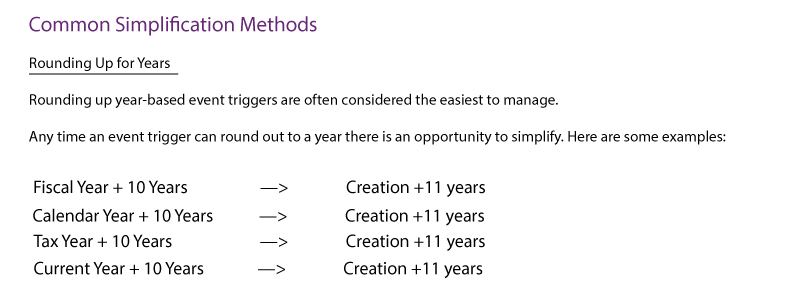If you find event triggers “triggering,” you are in good company. Event trigger complexities are a top peeve among records management professionals. While some event triggers are unavoidable, many can be simplified. The following guidance will help you dig into your organization’s records management policy and increase adherence by making retention periods easier to follow and implement.
What is an event trigger?
Also known as “event-based retention,” event triggers start the disposition process by providing a specific occurrence that begins the specified period required before disposition. An event trigger often aligns with the natural lifecycle of a record. For example, a common event trigger for personnel records is “Duration of Employment.” This is in line with the lifecycle for a personnel record and its usefulness, spanning the creation beginning at the time of hiring through the end of employment. Once the employment ends, the fixed retention period begins. Duration of Employment + 7 Years is a common retention period for these records.
Beyond practical lifecycle considerations, event triggers may be mandated by legal regulatory requirements, as is the case for personnel records. Effective and compliant event triggers need to consider both lifecycle and regulatory factors.
Why are event triggers so triggering?
When the requisite event has either begun or concluded is often difficult to determine. In the case of “Duration of Employment,” your HR department can provide information about an employee’s “Duration of Employment.” To begin the period of retention, this trigger determination is contingent on getting additional information. Many event triggers require coordination and input from multiple individuals, adding a hurdle to the disposition process.
In contrast, a retention of “Creation” or “Calendar Year” can easily be automated within a system and is not contingent upon additional information. These simplified and straightforward “flat” retention periods are preferred and more easily actionable. Fewer hurdles equal a higher likelihood of adherence and effective disposition.

Each of these event triggers can be calculated to occur within one year. So, by adding on a year and using a default creation date as the trigger, you create a simplified retention period as tracking creation is much easier and allows you to standardize. While you may add some time to the retention period by rounding up, the amount of time is small, and the benefit from increased adherence typically outweighs any drawbacks.
Calculable Retention Periods
Products
Some of the most difficult event triggers to implement are those tied to a specific event that has wide variation and may require input from multiple knowledgeable individuals to determine when an event has been triggered. Here are a couple of the biggest offenders:

These event triggers are used for a few reasons. Primarily, there are often regulations and standards that require certain records to be kept for the duration of the life of a product or following the shelf life or expiration of a lot, batch, or other type. This is to ensure records are made available in case of a quality issue or recall, for instance.
Additionally, these triggers speak to the records lifecycle as certain records that support design certifications or marketing authorizations need to be kept for as long as a product is on the market. Often, it’s possible to calculate the life or shelf life of a product. For instance, if the expected life of a drug is 1 year, a shelf life of 1 year plus 5 years would equal a total retention period of Creation + 6 Years.
For each, you may gather additional information to get a sense of when and how frequently these events trigger. For example, many record types are periodically reviewed and superseded on an annual basis. When that happens, superseded (1 Year) plus 3 years would result in a simplified retention period of Creation + 4 Years. If the lifecycle of a project is typically no more than 2 years, then project completion (2 Years) plus 5 years equals 7 years. Depending on the complexity and diversity of your organization’s processes and their related records lifecycle, you can use a similar type of determination for the other event trigger categories listed above.
But Can I Get Rid of All Event Triggers?
Unfortunately, despite your best efforts, you’ll still find it difficult to get rid of some event triggers. “Duration of Employment” is a good example of a necessary event trigger. This is due to the variability in the amount of time of employment, regulatory recordkeeping requirements, and personal information risks for over-retention. A simplified calculated retention period for “Duration of Employment” runs the risks of either under or over-retention for specific employee records.
Conclusion
Retention schedule simplification is a growing trend, especially when it comes to implementing retention periods across systems with varying event trigger capabilities. With a little investigation, you can simplify many types of event triggers within your organization’s records retention schedule. It’s helpful to gather insight from stakeholders who can confirm essential information. Calculable retention periods depend on details surrounding records lifecycles and the nature of various products. But this effort on the front end will pay off through increased records retention schedule adherence, hopefully leaving you tickled instead of triggered.
Disclaimer: The purpose of this post is to provide general education on Information Governance topics. The statements are informational only and do not constitute legal advice. If you have specific questions regarding the application of the law to your business activities, you should seek the advice of your legal counsel.

